
A kilt is a garment resembling a wrap-around knee-length skirt, made of twill-woven worsted wool with heavy pleats at the sides and back and traditionally a tartan pattern. Originating in the Scottish Highland dress for men, it is first recorded in the 16th century as the great kilt, a full-length garment whose upper half could be worn as a cloak. The small kilt or modern kilt emerged in the 18th century, and is essentially the bottom half of the great kilt. Since the 19th century, it has become associated with the wider culture of Scotland, and more broadly with Gaelic or Celtic heritage.
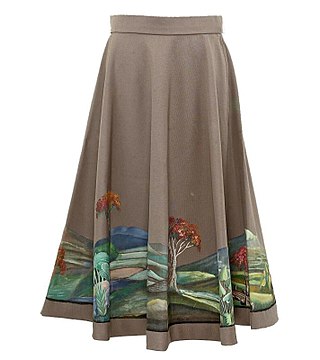
A skirt is the lower part of a dress or a separate outer garment that covers a person from the waist downwards. At its simplest, a skirt can be a draped garment made out of a single piece of fabric. However, most skirts are fitted to the body at the waist or hips and fuller below, with the fullness introduced by means of darts, gores, pleats, or panels. Modern skirts are usually made of light to mid-weight fabrics, such as denim, jersey, worsted, or poplin. Skirts of thin or clingy fabrics are often worn with slips to make the material of the skirt drape better and for modesty.

Highland games are events held in spring and summer in Scotland and other countries with a large Scottish diaspora, as a way of celebrating Scottish and Celtic culture, especially that of the Scottish Highlands. Certain aspects of the games are so well known as to have become emblematic of Scotland, such as the bagpipes, the kilt, and the heavy events, especially the caber toss and weight over bar. While centred on competitions in piping and drumming, dancing, and Scottish heavy athletics, the games also include entertainment and exhibits related to other aspects of Scottish and Gaelic cultures.

A folk costume expresses a national identity through clothing or costume, which is usually associated with a specific region or period of time in history. It can also indicate social, marital, or religious status. If the costume is used to represent the culture or identity of a specific ethnic group, it is usually known as ethnic costume. Such costumes often come in two forms: one for everyday occasions, the other for traditional festivals and formal wear. The word "costume" in this context is sometimes considered pejorative due to the multiple senses of the word, and in such cases "clothing", "garments" or "regalia" can be substituted without offense.
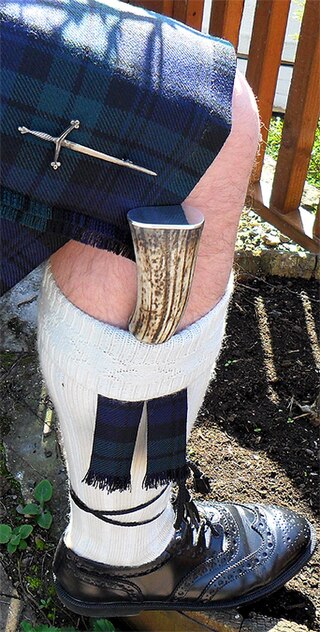
The sgian-dubh – also anglicized as skene-dhu – is a small, single-edged knife worn as part of traditional Scottish Highland dress. Originally used for eating and preparing fruit, meat, and cutting bread and cheese, as well as serving for other more general day-to-day uses such as cutting material and protection, it is now worn as part of traditional Scottish dress tucked into the top of the kilt hose with only the upper portion of the hilt visible. The sgian-dubh is normally worn on the same side as the dominant hand.
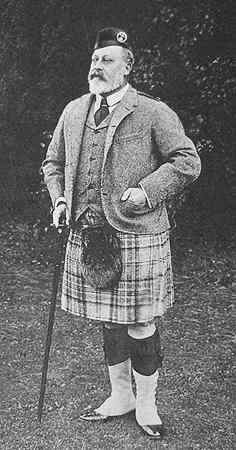
Highland dress is the traditional, regional dress of the Highlands and Isles of Scotland. It is often characterised by tartan. Specific designs of shirt, jacket, bodice and headwear may also be worn along with clan badges and other devices indicating family and heritage.

Highland dance or Highland dancing is a style of competitive dancing developed in the Scottish Highlands in the 19th and 20th centuries, in the context of competitions at public events such as the Highland games. It was created from the Gaelic folk dance repertoire, but formalised with the conventions of ballet, and has been subject to influences from outside the Highlands. Highland dancing is often performed with the accompaniment of Highland bagpipe music, and dancers wear specialised shoes called ghillies or pumps. It is now seen at nearly every modern-day Highland games event.

'Aboyne dress' is the name given to the prescribed attire for female dancers in the Scottish national dances, such as the Flora MacDonald's fancy, the Scottish lilt, and others. Male dancers wear the kilt for these dances, the kilt being a predominantly male garment. There are two versions of Aboyne Dress in use. Some consider the Aboyne as quite suited to the graceful movements of the national dances.

The brogue is a style of low-heeled shoe or boot traditionally characterised by multiple-piece, sturdy leather uppers with decorative perforations and serration along the pieces' visible edges.

Trews are men's clothing for the legs and lower abdomen, a traditional form of tartan trousers from Scottish Highland dress. Trews could be trimmed with leather, usually buckskin, especially on the inner leg to prevent wear from riding on a horse.

The modern, tailored kilt which is ubiquitous at Highland games gatherings around the world has associated with it an evolving style of wear. This style includes the accessories and other accoutrements which are typically worn with it. In this sense, it is very much like other items of the fashion world.

The history of the modern kilt stretches back to at least the end of the 16th century. The kilt first appeared as the belted plaid or great kilt, a full-length garment whose upper half could be worn as a cloak draped over the shoulder, or brought up over the head as a hood. The small kilt or walking kilt did not develop until the late 17th or early 18th century, and is essentially the bottom half of the great kilt.

The kilt pin is a piece of jewellery that is usually worn on the lower corner of the outer apron of a kilt. Its function is to prevent the apron falling or blowing open, by adding weight to the outer apron, and it is commonly seen as a form of decoration. It does not pin the outer apron to the inner fabric, which is a common misconception.

Outside Western cultures, men's clothing commonly includes skirts and skirt-like garments; however, in the Americas and much of Europe, skirts are usually seen as feminine clothing and socially stigmatized for men and boys to wear, despite having done so for centuries. While there are exceptions, most notably the cassock and the kilt, these are not really considered 'skirts' in the typical sense of fashion wear; rather they are worn as cultural and vocational garments. People have variously attempted to promote the fashionable wearing of skirts by men in Western culture and to do away with this gender distinction.
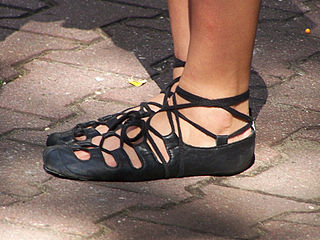
Ghillies are specially designed shoes used for several types of dance. They are soft shoes, similar to ballet shoes. They are used by women in Irish dance, by men and women in Scottish country dance, and by men and women in Scottish highland dance.
In Scottish folklore the Ghillie Dhu or Gille Dubh was a solitary male fairy. He was kind and reticent, yet sometimes wild in character. He had a gentle devotion to children. Dark-haired and clothed in leaves and moss, he lived in a birch wood within the Gairloch and Loch a Druing area of the north-west Highlands of Scotland. Ghillie Dhu is the eponym for the ghillie suit.

A jabot is a decorative clothing-accessory consisting of lace or other fabric falling from the throat, suspended from or attached to a neckband or collar, or simply pinned at the throat. Its current form evolved from the frilling or ruffles decorating the front of a shirt in the 19th century.

"True Scotsman" is a humorous term used in Scotland for a man wearing a kilt without undergarments. Though the tradition originated in the military, it has entered Scottish lore as a rite, an expression of light-hearted curiosity about the custom, and even as a subversive gesture.
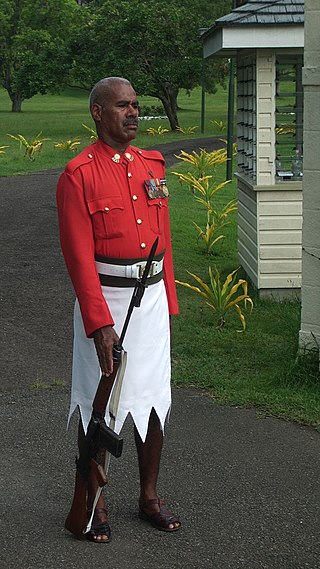
A sulu is a kilt-like garment worn by men and women in Fiji since colonisation in the nineteenth century.
A gillie or ghillie is an assistant who attends to a person who is hunting or fishing in Scotland.


















